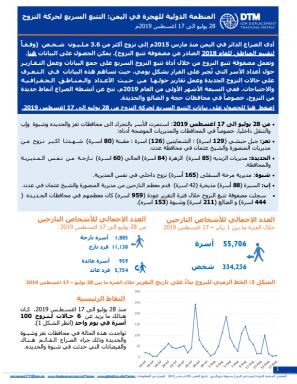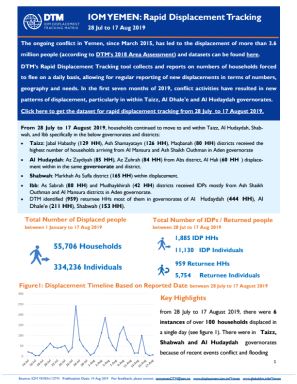-
Countries
-
Data and Analysis
-
Special Focus
-
Crisis Responses
Yemen
IDPs tracked
Displacement Movements
4,523,000
IDMC 2022
Data collection round
About Yemen
Overview
The situation in Yemen has steadily deteriorated as a result of instability and increased fighting between multiple groups. Large scale internal displacement has been observed across the country since the conflict started in 2015. IOM Yemen’s DTM was launched the same year in an effort to better inform the humanitarian community about the location and needs of displaced populations. The DTM identifies both IDP and returnee locations and tracks displacement trends on a daily basis. The DTM also monitors key migrant arrivals and the return of Yemeni migrants mainly in locations across Yemen’s southern coastal border and northern border with the Kingdom of Saudi Arabia (KSA).
Rapid Displacement Tracking (RDT)
As part of the DTM’s mobility tracking, Rapid Displacement Tracking (RDT) primarily tracks IDP and returnee populations throughout Yemen. Information on areas of displacement and return, origins and reasons for displacement, shelter types, and priority needs are collected on a daily basis. RDT data is not representative of all displacements occurring in Yemen due to access constraints in many governorates.
Area Assessment (AA)
The Area Assessment collects stock figures on the number of IDPs, returnees, and migrants, as well as the origins, reasons for displacement, shelter types, and the situation overview at a target location. The Area Assessment data is collected through an extensive key informant network at the smallest geographical area that is operationally possible. This assessment is used to verify and update the baseline information in quarterly cycles, with field staff revisiting and updating information on all previously identified locations populated by IDP and returnee populations.
Flow Monitoring Registry (FMR)
The DTM’s Flow Monitoring Registry (FMR) monitors key third-country migrant arrivals and departures mainly in locations across Yemen’s southern coastal border as well as key Yemeni returns on the northern border with the KSA. Enumerators placed at Flow Monitoring Points (FMPs) record arrivals of migrants and returning Yemeni nationals in order to identify different patterns and types of migration, and to provide quantitative estimates to help define the population of irregular migrants entering the country. FMR is not representative of all flows in Yemen and should be understood only as indicative of the individuals recorded at FMPs during the timeframe indicated. Access constraints limit the ability to collect data at some migrant arrival points.
Multi-Cluster Location Assessment (MCLA)
In order to carry out an evidenced-based needs analysis for the Humanitarian Needs Overview (HNO), and to allow humanitarian partners to make planning decisions, the Yemen Inter-Cluster Coordination Mechanism (ICCM) proposed to carry out a Multi-Cluster Location Assessment (MCLA). This also involves the Technical Working Group (TWG) to formulate planning and implementation processes, as well as data examination and compilation. This assessment is based on the MCLA tool that has been used to assess IDP needs in previous years but has been broadened to include all key population groups that are in need of humanitarian assistance according to the previous HNO. The MCLA will provide nationwide data and evidence-based findings for the HNO to better inform the Humanitarian Response Plan (HRP) in Yemen.
Contact
Current Donors
- Canada
- ECHO
- GFFO
- BHA
Yemen - Rapid Displacement Tracking Report (17 Nov – 23 Nov 2019)
From 01 January-23 November 2019, IOM Yemen DTM estimates that 64,506 Households or 387,036 Individuals have experienced displacement, at least once.
Yemen - Rapid Displacement Tracking Report (01 Jan – 16 Nov 2019)
The ongoing conflict in Yemen, since March 2015, has led to the displacement of more than 3.6 million people (according to DTM's 2018 Area Assessment).
اليمن_ نقاط تتبع التدفق | المهاجرون الوافدون واليمنيون العائدون من المملكة العربية السعودية في أكتوبر2019
تعمل مصفوفة تتبع النزوح DTM في اليمن على مراقبة المواقع الرئيسية للمهاجرين الوافدين والعائدين في الحدود الشمالية لليمن مع المملكة العربية السعودية والحدود الساحلية الجنوبية.
Yemen — Flow Monitoring Points | Migrant Arrivals and Yemeni Returns From Saudi Arabia in October 2019
Displacement Tracking in Yemen includes the monitoring of key migrant and return locations on Yemen's northern border with Saudi Arabia and southern coastal border.
Yemen - Rapid Displacement Tracking Report (01 Jan – 09 Nov 2019)
The ongoing conflict in Yemen, since March 2015, has led to the displacement of more than 3.6 million people (according to DTM's 2018 Area Assessment).
Yemen - Rapid Displacement Tracking Report (01 Jan –02 Nov 2019)
The ongoing conflict in Yemen, since March 2015, has led to the displacement of more than 3.6 million people (according to DTM's 2018 Area Assessment).
Yemen - Rapid Displacement Tracking Report (01 Jan – 26 Oct 2019)
The ongoing conflict in Yemen, since March 2015, has led to the displacement of more than 3.6 million people (according to DTM's 2018 Area Assessment).
Yemen - Rapid Displacement Tracking Report (01 Jan – 19 Oct 2019)
The ongoing conflict in Yemen, since March 2015, has led to the displacement of more than 3.6 million people (according to DTM's 2018 Area Assessment).
اليمن_ نقاط تتبع التدفق | المهاجرون الوافدون واليمنيون العائدون من المملكة العربية السعودية في سبتمبر 2019
تعمل مصفوفة تتبع النزوح DTM في اليمن على مراقبة المواقع الرئيسية للمهاجرين الوافدين والعائدين في الحدود الشمالية لليمن مع المملكة العربية السعودية والحدود الساحلية الجنوبية.
Yemen — Flow Monitoring Points | Migrant Arrivals And Yemeni Returns From Saudi Arabia in September 2019
Displacement Tracking in Yemen includes the monitoring of key migrant and return locations on Yemen's northern border with Saudi Arabia and southern coastal border. Enumerators placed at Flow Monitoring Points (FMPs) monitor the arrivals of migrants and Yemeni nationals in order
Yemen - Rapid Displacement Tracking Report (01 Jan – 12 Oct 2019).
The ongoing conflict in Yemen, since March 2015, has led to the displacement of more than 3.6 million people (according to DTM's 2018 Area Assessment).
Yemen - Rapid Displacement Tracking Report (01 Jan – 06 Oct 2019).
The ongoing conflict in Yemen, since March 2015, has led to the displacement of more than 3.6 million people (according to DTM's 2018 Area Assessment).
Yemen - Rapid Displacement Tracking Report (01 Jan – 28 Sep 2019).
The ongoing conflict in Yemen, since March 2015, has led to the displacement of more than 3.6 million people (according to DTM's 2018 Area Assessment).
Yemen - Rapid Displacement Tracking Report (01 Jan – 21 Sep 2019).
The ongoing conflict in Yemen, since March 2015, has led to the displacement of more than 3.6 million people (according to DTM's 2018 Area Assessment).
Yemen - Rapid Displacement Tracking Report (01 Jan – 15 Sep 2019).
The ongoing conflict in Yemen, since March 2015, has led to the displacement of more than 3.6 million people (according to DTM's 2018 Area Assessment).
Yemen - Rapid Displacement Tracking Report (01 Jan – 31 Aug 2019).
The ongoing conflict in Yemen, since March 2015, has led to the displacement of more than 3.6 million people (according to DTM's 2018 Area Assessment).DTM’s Rapid Displacement Tracking tool collects and reports on numbers of households forced to flee on a daily basis, allowing f
Yemen - Rapid Displacement Tracking Report (01 Jan – 07 Sep 2019).
The ongoing conflict in Yemen, since March 2015, has led to the displacement of more than 3.6 million people (according to DTM’s 2018 Area Assessment).DTM’s Rapid Displacement Tracking tool collects and reports on numbers of households forced to flee on a daily basis, allowing for
اليمن_ نقاط تتبع التدفق | المهاجرون الوافدون واليمنيون العائدون من المملكة العربية السعودية في اغسطس2019
تعمل مصفوفة تتبع النزوح DTM في اليمن على مراقبة المواقع الرئيسية للمهاجرين الوافدين والعائدين في الحدود الشمالية لليمن مع المملكة العربية السعودية والحدود الساحلية الجنوبية.
Yemen — Flow Monitoring Points | Migrant Arrivals And Yemeni Returns From Saudi Arabia in August 2019
Displacement Tracking in Yemen includes the monitoring of key migrant and return locations on Yemen's northern border with Saudi Arabia and southern coastal border. Enumerators placed at Flow Monitoring Points (FMPs) monitor the arrivals of migrants and
(اليمن – تقرير التتبع السريع لحركة النزوح (28 يوليو - 17 اغسطس 2019
أدى الصراع الدائر في اليمن منذ مارس 2015م إلى نزوج أكثر من 3.6 مليون شخص (وفقاً لتقييم المواقع للعام 2018 الصادر عن مصفوفة تتبع النزوح).
Yemen - Rapid Displacement Tracking Report (28 July – 17 August 2019).
The ongoing conflict in Yemen, since March 2015, has led to the displacement of more than 3.6 million people (according to DTM’s 2018 Area Assessment).DTM’s Rapid Displacement Tracking tool collects and reports on numbers of households forced to flee on a daily basis, allowing for
اليمن_ نقاط تتبع التدفق | المهاجرون الوافدون واليمنيون العائدون من المملكة العربية السعودية في يوليو 2019
تعمل مصفوفة تتبع النزوح DTM في اليمن على مراقبة المواقع الرئيسية للمهاجرين الوافدين والعائدين في الحدود الشمالية لليمن مع المملكة العربية السعودية والحدود الساحلية الجنوبية.
Yemen — Flow Monitoring Points | Migrant Arrivals And Yemeni Returns From Saudi Arabia From in July 2019
Displacement Tracking in Yemen includes the monitoring of key migrant and return locations on Yemen's northern border with Saudi Arabia and southern coastal border.
(اليمن – تقرير التتبع السريع لحركة النزوح (14 - 27 يوليو 2019
أدى الصراع الدائر في اليمن منذ مارس 2015م إلى نزوج أكثر من 3.6 مليون شخص (وفقاً لتقييم المواقع للعام 2018 الصادر عن مصفوفة تتبع النزوح).
Pagination
Pagination
- First page
- Previous page
- …
- 6
- 7
- 8
- 9
- 10
- 11
- 12
- 13
- 14

























